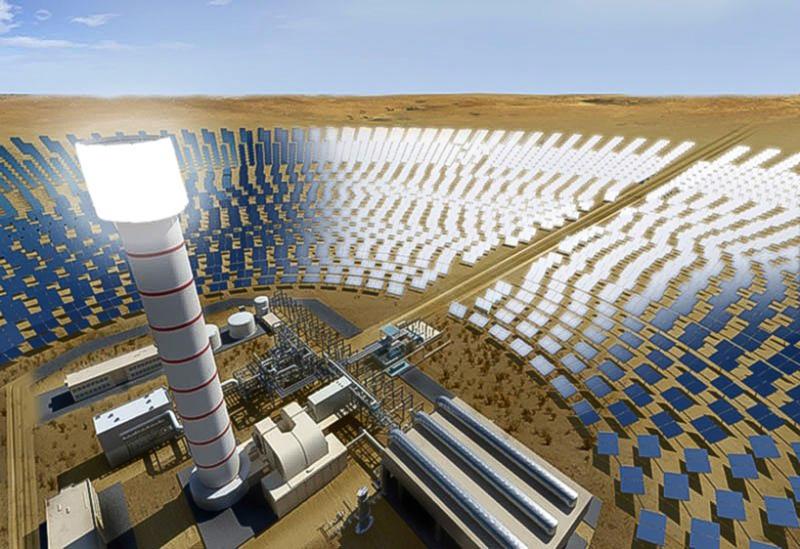New Advances in Optimization Scheduling of Industrial Park Energy Systems with Hybrid Energy Storage | Newswise – Newswise

Report on the Optimization of Industrial Park Energy Systems for Sustainable Development
Introduction: Aligning Industrial Infrastructure with Global Sustainability Targets
Industrial parks are pivotal to national economic strategies but present significant challenges to achieving global climate and sustainability objectives, particularly China’s goals for carbon peak and neutrality. The high energy consumption and substantial carbon footprint of these parks are in direct conflict with several Sustainable Development Goals (SDGs). A recent study addresses this issue by developing an optimized energy system model that integrates hybrid energy storage, directly contributing to progress on key SDGs.
Challenges in Sustainable Energy Management for Industry
The transition to low-carbon industrial operations is central to achieving SDG 9 (Industry, Innovation, and Infrastructure) and SDG 13 (Climate Action). However, this transition faces two primary obstacles:
- Renewable Energy Integration: While essential for SDG 7 (Affordable and Clean Energy), renewable sources like solar and wind are intermittent, creating instability when matched with the variable load demands of industrial parks.
- Energy Storage Limitations: Existing energy storage technologies have operational constraints, and prior optimization models have often been limited to passive, rule-based control, hindering efficiency and economic viability.
A Novel Framework for Sustainable Industrial Energy
To overcome these challenges, researchers have proposed an innovative optimization framework designed to enhance the sustainability of industrial parks.
Methodology for Multi-Objective Optimization
The research methodology incorporates several advanced components to align with sustainability principles:
- IPES-HES Model: A detailed model for an Industrial Park Energy System with Hybrid Energy Storage (IPES-HES) was developed, accounting for the unique characteristics of various energy devices.
- Active Operation Strategy: An active, forward-looking operational strategy was proposed, using the next day’s hourly power output of energy storage as key decision variables for optimization.
- Optimization Algorithm: The non-dominated sorting genetic algorithm II (NSGA-II) was employed to solve a configuration model with the dual objectives of minimizing economic cost and reducing carbon emissions, directly supporting SDG 12 (Responsible Consumption and Production).
- Day-Ahead Scheduling: A nonlinear optimization scheduling method was developed to guide operations based on the optimized system configuration.
Significant Findings and Contributions to Sustainable Development Goals
The study yielded significant results, demonstrating a viable pathway toward more sustainable industrial operations.
Quantitative Impact on Energy Efficiency and Cost
On a typical summer day, the optimized IPES-HES model demonstrated substantial improvements compared to a conventional proportional electricity storage strategy:
- Economic Performance: The system energy bill was reduced by 5.5% (181.4 USD).
- Grid Reliability: The peak power demand was reduced by 43.7% (1600.3 kW), enhancing grid stability and contributing to the resilience of community infrastructure under SDG 11 (Sustainable Cities and Communities).
Direct Contributions to the SDGs
This research provides tangible contributions to multiple Sustainable Development Goals:
- SDG 7 (Affordable and Clean Energy): It advances the deployment of reliable and modern energy systems by effectively managing renewable energy and improving efficiency.
- SDG 9 (Industry, Innovation, and Infrastructure): The study fosters innovation in industrial infrastructure, promoting sustainable industrialization by creating a blueprint for low-carbon energy management.
- SDG 11 (Sustainable Cities and Communities): By reducing peak loads on the energy grid, the model helps build more resilient and sustainable energy infrastructure for the communities hosting these industrial parks.
- SDG 13 (Climate Action): The core objective of reducing carbon emissions provides a direct and practical strategy for climate change mitigation at the industrial level.
Future Directions and Policy Implications
The research outlines a clear path for future work, focusing on integrating load flexibility into the IPES-HES to further enhance the utilization of renewable energy. This study offers critical theoretical support and practical guidance for policymakers and industrial park operators aiming to align with national and international climate targets, providing a scalable model for sustainable industrial development worldwide.
Reference
Guo, J., Luo, Y., Zou, B., & Peng, J. (2024). Day-Ahead Nonlinear Optimization Scheduling for Industrial Park Energy Systems with Hybrid Energy Storage. Engineering. https://doi.org/10.1016/j.eng.2024.10.006
SDGs Addressed or Connected to the Issues Highlighted in the Article
- SDG 7: Affordable and Clean Energy – The article’s core focus is on optimizing energy systems, integrating renewable energy, and improving energy efficiency in industrial parks.
- SDG 9: Industry, Innovation, and Infrastructure – The research provides an innovative solution for upgrading industrial infrastructure (industrial parks) to make them more sustainable and efficient.
- SDG 11: Sustainable Cities and Communities – By reducing carbon emissions and energy consumption in industrial parks, which are often part of or near urban areas, the study contributes to reducing the overall environmental impact of cities.
- SDG 13: Climate Action – The primary motivation for the study is to help China achieve its “carbon peak and carbon neutrality goals” by tackling the “large carbon emissions” from industrial parks.
Specific Targets Identified Based on the Article’s Content
-
SDG 7: Affordable and Clean Energy
- Target 7.2: By 2030, increase substantially the share of renewable energy in the global energy mix.
Explanation: The article explicitly states that “renewable energy is a key to low-carbon operations in industrial parks” and the proposed optimization aims to “improve renewable energy utilization” by addressing its intermittency with hybrid energy storage. - Target 7.3: By 2030, double the global rate of improvement in energy efficiency.
Explanation: The study addresses the problem of “high energy consumption” in industrial parks. The proposed optimization strategy resulted in a significant reduction in peak power demand by 43.7%, which is a direct measure of improved energy efficiency.
- Target 7.2: By 2030, increase substantially the share of renewable energy in the global energy mix.
-
SDG 9: Industry, Innovation, and Infrastructure
- Target 9.4: By 2030, upgrade infrastructure and retrofit industries to make them sustainable, with increased resource-use efficiency and greater adoption of clean and environmentally sound technologies and industrial processes.
Explanation: The research focuses on retrofitting the energy systems of industrial parks with “hybrid energy storage (IPES-HES)” and an “active operation strategy.” This is a direct application of innovative and clean technology to make industrial processes more sustainable.
- Target 9.4: By 2030, upgrade infrastructure and retrofit industries to make them sustainable, with increased resource-use efficiency and greater adoption of clean and environmentally sound technologies and industrial processes.
-
SDG 11: Sustainable Cities and Communities
- Target 11.6: By 2030, reduce the adverse per capita environmental impact of cities, including by paying special attention to air quality and municipal and other waste management.
Explanation: The article’s goal of “carbon emission lowering” in industrial parks directly contributes to reducing the adverse environmental impact of these industrial zones on the surrounding communities and cities.
- Target 11.6: By 2030, reduce the adverse per capita environmental impact of cities, including by paying special attention to air quality and municipal and other waste management.
-
SDG 13: Climate Action
- Target 13.2: Integrate climate change measures into national policies, strategies and planning.
Explanation: The study is framed within the context of “China’s pursuit of carbon peak and carbon neutrality goals,” which are national climate policies. The research provides a practical strategy for implementing these national goals at the local, industrial level.
- Target 13.2: Integrate climate change measures into national policies, strategies and planning.
Indicators Mentioned or Implied for Measuring Progress
-
Indicators for SDG 7
- Implied Indicator for Target 7.2: Share of renewable energy. The article discusses the challenge of renewable energy’s “intermittency” and the goal to “improve renewable energy utilization,” implying that measuring the increased use of renewables is a key metric.
- Mentioned Indicator for Target 7.3: Reduction in energy consumption and peak power. The article quantifies progress by stating that the “peak power of the IPES-HES… were reduced by… 1600.3 kW (43.7%).” This serves as a direct indicator of improved energy efficiency.
-
Indicators for SDG 9
- Implied Indicator for Target 9.4: CO2 emissions per unit of industrial output. The article identifies “large carbon emissions” as a key problem and “carbon emission lowering” as a primary goal of the optimization model, implying that the reduction of CO2 is a core metric for success.
-
Indicators for SDG 11
- Implied Indicator for Target 11.6: Level of air pollution (e.g., carbon emissions). The goal of “carbon reduction” directly relates to indicators measuring the environmental impact of industrial activities on urban areas.
-
Indicators for SDG 13
- Mentioned Indicator for Target 13.2: Reduction in total greenhouse gas emissions. The article’s entire premise is to contribute to “carbon peak and carbon neutrality goals” by achieving “carbon reduction,” making the amount of carbon emissions reduced a critical indicator. The reduction of the “system energy bill by 181.4 USD (5.5%)” also serves as an economic indicator tied to reduced energy (and thus carbon) consumption.
Summary of SDGs, Targets, and Indicators
| SDGs | Targets | Indicators |
|---|---|---|
| SDG 7: Affordable and Clean Energy | 7.2: Increase the share of renewable energy. 7.3: Improve energy efficiency. |
Improved renewable energy utilization. Reduction in peak power demand (reduced by 43.7%). |
| SDG 9: Industry, Innovation, and Infrastructure | 9.4: Upgrade infrastructure and retrofit industries to make them sustainable. | Adoption of hybrid energy storage (IPES-HES) and optimization models. Goal of “carbon emission lowering.” |
| SDG 11: Sustainable Cities and Communities | 11.6: Reduce the adverse per capita environmental impact of cities. | Goal of “carbon reduction” in industrial parks located within or near cities. |
| SDG 13: Climate Action | 13.2: Integrate climate change measures into national policies and planning. | Contribution to national “carbon peak and carbon neutrality goals.” Reduction in system energy bill (reduced by 5.5%). |
Source: newswise.com

What is Your Reaction?
 Like
0
Like
0
 Dislike
0
Dislike
0
 Love
0
Love
0
 Funny
0
Funny
0
 Angry
0
Angry
0
 Sad
0
Sad
0
 Wow
0
Wow
0












































































